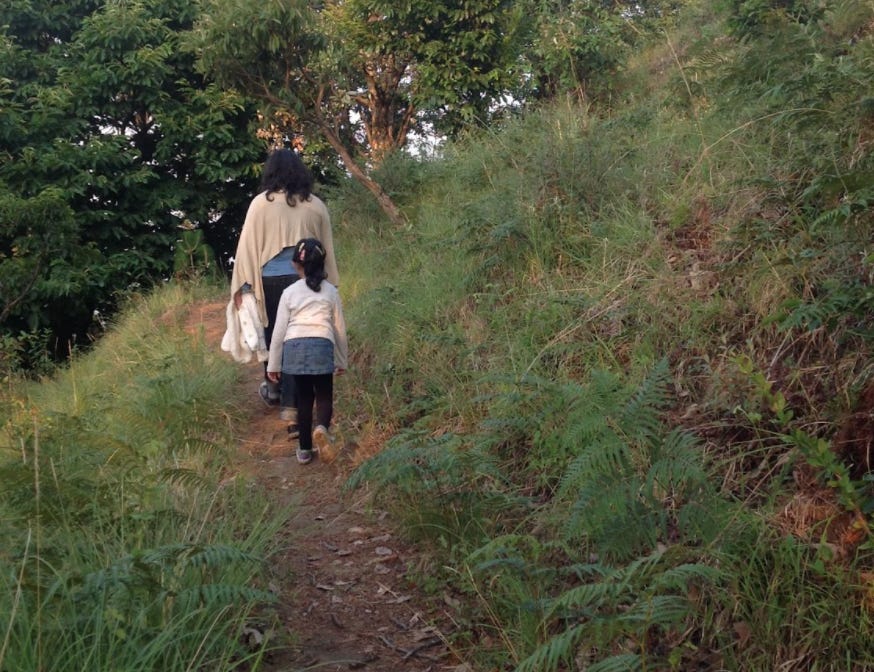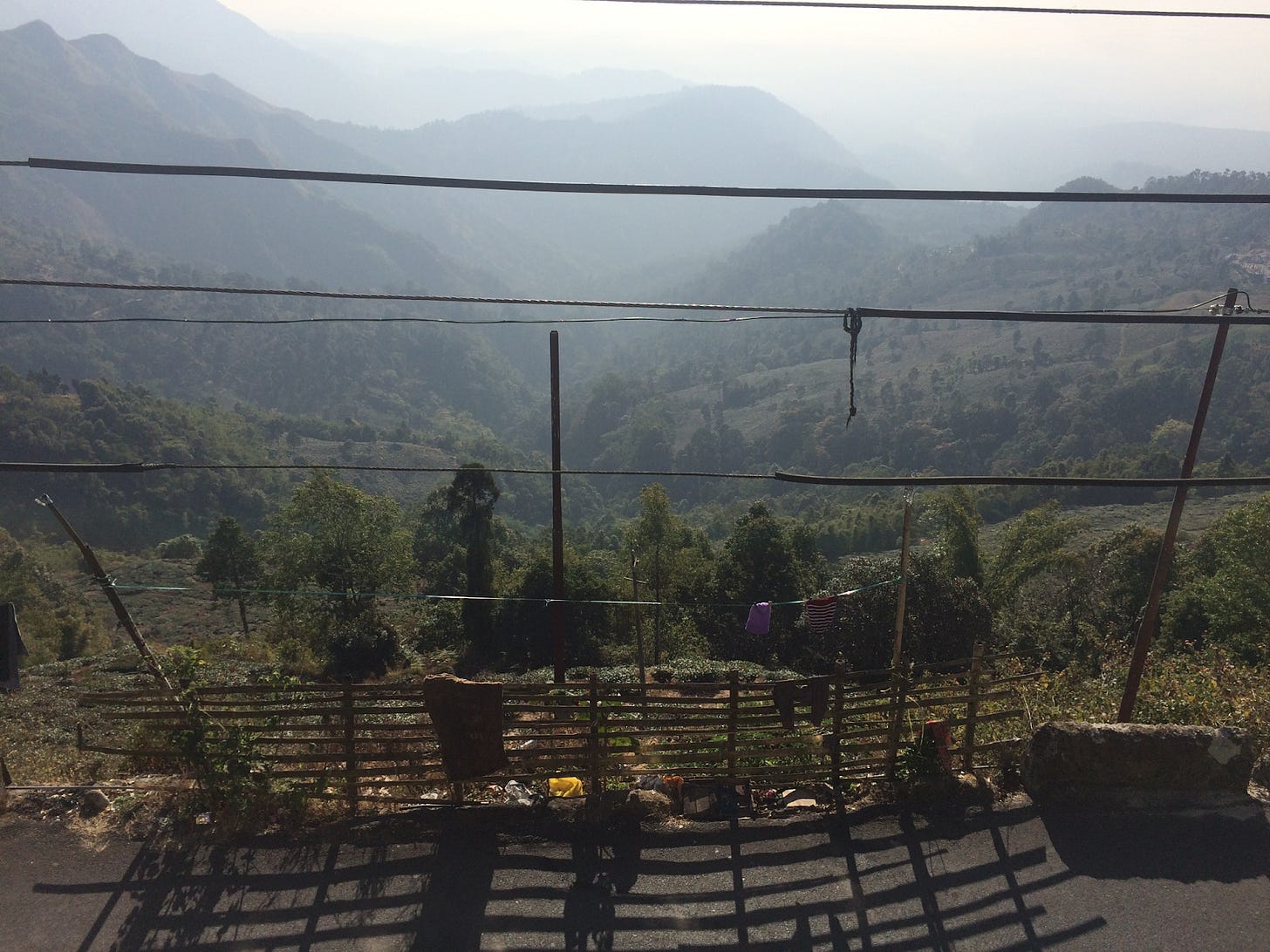Spring in the Hills
Bees Saal Pehle, or is it Baad?
Change that moves mountains. Literally. P’s walks through the Himalayas over the decades stand witness to some changes inside out. Personal, political, natural, imposed. An unfolding of Time, notes on Mortality, thoughts on Growth, visited and revisited via pictures and words.
The hills are alive with the sound of… birdcalls? Breeze rustling through the leaves? The dogs bounding around? Buzzing bees spreading pollen?
Well, not so much.
Let’s try that again.
The hills are alive with the sound of… construction work. Drilling. Boring. Generators. Clanging tools that sound like a call to arms. Punjabi rap. The rustling of the fallen leaves under your feet, that satisfying sensory crunch, drowned out by ‘Soni Kudi’ hollabacks somewhere in the valley below. On loop. Oh, and the Swachh Bharat Abhiyan campaigns. (‘Ghar se kachra nikaal’, goes the most frustrating earworm you’ll ever hear).
Spring in the hills of Uttarakhand in 2022 sure feels different from the early 2000s spring in the hills of Uttarakhand.
There is of course a pandemic to consider. As my first real time out since 2020, it’s bound to feel different. The roadtrip to Bhimtal somehow felt more like a homecoming. But also slightly overwhelming. A favourite pitstop for old memories’ sake, but double-masked. Snacks in the car. And PayTM karo.
But there’s more. There’s a first time-ness about the seeping in of the years - they tell on the mountains, which wear and tear much like I do. (I find myself more mindful of my yoga practice and consuming my greens than sleeping in and beer and such like). Except nature weighs in more for me as a “natural” passing of time. While some of the changes in the hills are more dramatic because they’re almost entirely manmade, driven by the hand of man, not time.
Consider the colours.
The yellows of the piyoli, local yellow jasmine, which are bursting everywhere, are fighting for a stake on the colour, since the bumble bee yellow bulldozers razing down yet more cliffs, laying down yet more roads, demand attention with their monstrous, attack-on-the-senses presence.
There wasn't so much wearing-your-identity-on-your-sleeve-via-colours either. It’s almost like a football jersey choice now. With the state’s election results declared recently, human chatter buzzes with colours of politics and political parties and the loud, blinding narratives painted with harsh, broad brushstrokes. The Mall Road I avoid. I’ve been told they have declared an early saffron-only Holi. There are fireworks in the sky, an artificial riot of colours puncturing the pink-orange sunsets I watch every evening creeping across and beyond the blooming greens spreading into the infinity of the blue and white skies. A young woman decides to skip dinner in town, the evening of the results. She feels afraid, she tells me. Colours as fearful, how did we get here? Was there a premonition of today, in that Holi you played T, which scarred you, I wonder?
But for every five (or more) years of storytelling and the changes these affect, there is that which remains unchanged. For all the mortality that feels real in a living-with-Covid world on the brink of (in the midst of?) World War III, the mountains do hint at immortality. You’ll be gone, they’ll be here. Eternal Time, Eternal Growth - If there’s one place that paints this for you in black and white, it’s here.
My soul is Pahadi, the hills have my heart, I have always affirmed. As someone who’s been walking and trekking through the mountains of northern India since the early 2000s - long before it was packaged as wanderlust - they’ve had a shape-shifting presence in my life.
They’ve been escapes and getaways and breaks, a piece of earth under the sky, their very existence for me an invitation to bond as chosen soulmates. They’ve been healing and rejuvenating, the natural fact of their grandiosity juxtaposed against the lightness of being they gift you. They’ve been deeply spiritual and philosophical, always urging, always interrogating, provocative, nudging you to think of purpose and the purpose of thinking about purpose, simultaneously. They’ve been places of joy and mirth and belonging and rest, the purest, most real life lessons. They also tell you that you are alone, hopefully not lonely. A secret best uncovered as you walk walk walk through them. As the mountains outside shift the mountains inside. The most powerful way to lose myself, in the best way possible.













A woman in her 70s, an intrepid traveler I meet here, who’s built a new life for herself having spent much of her youth in misery (“it’s like I’ve been a prisoner all my life”), tells me she waits for that moment every morning when she can first catch a glimpse of the mountains. ‘They are so peaceful, and also so strong. It’s like nothing untoward can happen now. The mountains will always protect you.’ I try and envision myself at her age (still walking the mountains I hope!), and wonder what tectonic shifts await me. As I admire, respect the mountains, equal parts awed, mystified, overwhelmed, grateful, pure joy. And walk along. Humming the Swachch Bharat slogan of course. Ghar ka kachra nikaalna toh aakhir bahut zaruri hai.
Love,
P
Postscript from T.
It is one thing to wish for clear skies without electric and cable lines corrupting the view, quite another to live under it.
My Himalayas are in the east–Darjeeling, Kurseong, Kalimpong. The last time I was there, it was for a research trip. I was researching places I remembered visiting on several occasions in the past for a creative piece. While I had previously treated the hills as a temporary address, this time I was intent on attending to the rhythms of daily life there. Life that my father had known and seen more closely, working as an engineer in charge of electricity in these towns and villages. I found myself in and around bazaars, roadside tea shacks and tea factories, bus stops, sand quarry. Manmade formations of course, and not always the most eco-friendly, but also sites of labor that make the hills inhabitable for the various communities.
There is little doubt that a lot of “development” projects in the hills are misguided and fail to account for the complex ecosystem, prioritizing human needs and profits (economic, political) over all else. But communities living in areas that are relatively untouched find themselves in precarious positions as well.
A man I ended up chatting with near a forest in the terai region asked me what I do. When I said I write he asked me if I could call attention to the poor living conditions of his village. I explained to him that I am a creative writer, and unfortunately the kind that takes a very long time to compose meaningful pieces, which is to say, I am not the agent of rapid change he wishes for me to be. At best I can serve as a witness. He was disappointed. He would be disappointed some more if he knew I have not yet published what I was working on back then.
More from T
T.’s personal essay on colonial attitudes to wilderness, overcrowding of US national parks, and what American outdoors meant to her when she was an international student and now that she is an economic migrant appeared in Catapult. The essay is also a paean to the 90s Liril advertisements.












Thank you T and J for sharing your mountains with us. The fire gong--and the ubiquity of fire making it redundant is metaphorically universal, isn't it. James Baldwin was prescient about the environment too--Fire Next Time--speaks to us on many levels. Kind regards to you both, -Janet
This has so much of the feel of being Pakistan. Another reminder of just how much overlaps for us on both sides of the border. The good and not so great.